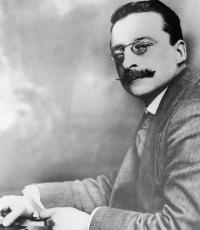Arthur Griffith and the development of Sinn Féin by Joseph E.A. Connell Jr
Published in 20th-century / Contemporary History, Book Reviews, Issue 4 (July/August 2011), Reviews, Volume 19
Dublin Castle and all the influential newspapers immediately labelled the 1916 Rising the ‘Sinn Féin rebellion’, though Griffith disapproved of it. (George Morrison)
In 1899 Arthur Griffith established the first of his separatist newspapers, The United Irishman. Through the power of his writing in The United Irishman, Sinn Féin and Nationality, Griffith shaped and set in motion many of the forces that influenced the organisations and individuals of the revolutionary years. Yet he spent his life in near poverty.
Griffith’s ideas ran far ahead of the times and influenced all segments of nationalist and separatist thought throughout Ireland. The young Griffith was a member of the Irish Republican Brotherhood, but later opposed the IRB’s ‘physical force’ aims. He believed that in the early twentieth century an armed Volunteer movement was no match for British military power.
Griffith sought to divert the Irish from their parliamentary attempt to win self-government through legislative action. Instead, he urged passive resistance as the way to achieve Home Rule. Irishmen were to refuse to pay British taxes, while Irish members of parliament were to stay away from Westminster and to sit in Ireland as a national council. This policy of ‘abstention’ was fundamental to the first Dáil Éireann, elected in 1918.
In September 1900 Griffith established Cumann na nGaedhael to unite separatist groups and clubs. In 1904 he published The resurrection of Hungary, in which he noted how in 1867 Hungary changed from being part of the Austrian Empire to being a separate, co-equal kingdom in Austria-Hungary. Though not a monarchist himself, Griffith advocated such an approach for Ireland, namely that Ireland should become a separate kingdom alongside Great Britain, the two forming a dual monarchy with a shared monarch but separate governments, as he thought that this solution would be more palatable to the British. By 1905 the name Sinn Féin had been transferred from the policy to its adherents, and most opt for 28 November 1905 as the founding date of the organisation because it was on that day that Griffith first presented this theory as the ‘Sinn Féin policy’.
In 1907 Cumann na nGaedhael merged with Sinn Féin and a number of other movements to form the Sinn Féin League. Máire de Bhuitléir (Mary Ellen Butler/Mrs Ó Nualláin, cousin of Edward Carson) suggested the name ‘Sinn Féin’. She was a language enthusiast and had used the name in her small news-sheet in Oldcastle, Co. Meath, in 1902–3. It came from the early motto of the Gaelic League: ‘Sinn féin, sinn féin amháin’ (‘Ourselves, ourselves alone’).
In 1907 Sinn Féin unsuccessfully contested a by-election in North Leitrim, where the sitting MP, Charles Dolan of Manorhamilton, had defected to Sinn Féin. At this time Sinn Féin, like all other nationalist/separatist organisations, was being infiltrated by the Irish Republican Brotherhood, who saw it as a vehicle for their aims. Later the IRB members argued that the aim of dual monarchism should be replaced by republicanism, and that Griffith was excessively inclined to compromise with conservative elements, notably in his pro-employer position during the 1913 Lockout.
The 1916 Rising was immediately labelled the ‘Sinn Féin rebellion’, though Griffith disapproved of it. The name stuck because the authorities of Dublin Castle and all the influential newspapers of the period wrongly identified Sinn Féin with separatist nationalism. Following the Rising, ‘Sinn Féin’ became the general term used by the British to denote all Irish nationalists. This misnomer did have the effect of uniting all the nationalists under a single political banner. Soon Griffith’s political party of the same name successfully wedded itself to the growing popularity of the Rising, and by 1918 it was the dominant party in Ireland, replacing the Irish Parliamentary Party as the legitimate voice of the Irish people. HI
Joseph E.A. Connell is the author of Where’s where in Dublin: a directory of historic locations, 1913–1923 (Dublin City Council, 2006).
Further reading:
C.P. Curran, ‘Griffith, MacNeill and Pearse’, in Studies, vol. LV (Spring 1966).
A. Griffith, The resurrection of Hungary, a parallel for Ireland (Dublin, 1904).
B. Maye, Arthur Griffith (Dublin, 1997).
















